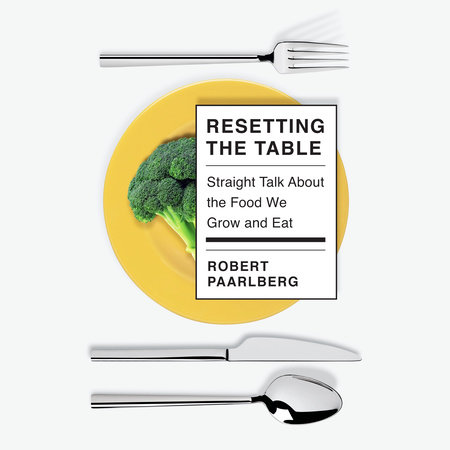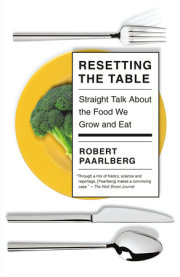Introduction
In 2008, I was attending a panel discussion on “sustainable food” at Harvard University, in the storied Faculty Room of University Hall. The purpose of the panel was to promote and celebrate good food, so we were served tasty hors d’oeuvres carefully sourced from local farmers and fishermen, beginning with demitasse cups of a delicious scallop chowder from Cape Cod Bay. The featured speakers were a celebrity restaurateur from the San Francisco Bay Area, a playwright from New York, and the young leader of Slow Food USA. It didn’t take long for all three to reach a lockstep conclusion: In the future, they said, sustainable food would have to be organic, local, and “slow,” definitely not fast or industrial.
Those at the event nodded their heads in assent, but I had a different take, having just returned from a research trip to rural Africa. I had been interviewing farmers in Uganda who were trapped inside a food system that was entirely organic, local, and slow. The women I had spoken with (most African farmers are women) did not know it, but they were living an extreme version of the Harvard dream. They were organic because they could not afford any nitrogen fertilizer; their food was all local because the rutted dirt roads made transport almost impossible during the rainy season; and their daily food preparation tasks were laboriously slow. Before cooking a porridge meal for their family these women had to strip, soak, dry, and then pound the maize kernels into flour, then carry in wood to build a fire plus water for the pot. Despite these efforts, many of their children were stunted from poor nutrition.
Farmers are important to me for personal as well as professional reasons. Both of my parents were from a farming background, and as a young teenager in the summer months I worked on my uncle’s Indiana farm, alongside my older brother and two cousins. We got up early to feed the cattle and hogs in the dark, before sitting down to our own breakfast. My cousins were still too young to drive a car, but they were handling powered machinery, working with animals four times their size, and they already knew things about farming well beyond the ken of most playwrights or big-city restaurateurs.
Discussions of food today can quickly turn into discussions about farming. Consumers not only want food to be tasty, safe, nutritious, and affordable; they also want it to come from farms that protect the natural environment, respect the welfare of animals, help sustain rural communities, and give hired workers a living wage. I share all of these goals, but my prescriptions differ from the Harvard panel’s dream. My research experience tells me not to yearn for an organic, local, or slow food system, since that would mean abandoning a century’s worth of modern science. It would force farmers to accept more toil and less income, consumers would be given fewer nutritious food choices, and greater destruction would be done to the natural environment. All this will be explained.
The use of modern science is broadly welcomed in medicine, transport, and communications, yet it has become strangely controversial in food production. Many of my friends in Massachusetts, where I live and work, hold a view that modern farming has become far too “industrial.” They agree with Mark Bittman, a former
New York Times columnist, who blames industrial farming for having “spawned an obesity crisis, poisoned countless volumes of land and water, wasted energy, tortured billions of animals.” They would also agree with Philip Lymbery, the author of
Farmageddon, who concludes that “every day there is a new confirmation of how destructive, inefficient, wasteful, cruel and unhealthy the industrial agriculture machine is. We need a total rethink of our food and farming systems before it’s too late.”
As their preferred alternative, many of my friends imagine a return to small, local, and chemical-free (organic) farms. These farms should produce a traditional mix of both crops and animals, as opposed to the specialized, industrial-scale farms that today produce just one or two crops and probably have no animals at all. When it comes to buying food, my friends would rather not be seen shopping in supermarkets, since too many items on the shelf are heavily processed or have traveled too many “food miles.” Their ideal, when they have plenty of time, is to buy unprocessed foods directly from local growers at a farmers market, or from a community supported agriculture (CSA) farm. They admire Alice Waters, proprietor of the acclaimed Chez Panisse restaurant in Berkeley (she was one of the speakers on the 2008 Harvard panel), who states with pride that she has not set foot in a supermarket for the past twenty-five years.
I hear all this, but I’m not persuaded. I want a food solution that works for all, including people who live on a budget and those without a lot of spare time. Dinners at Chez Panisse must be a wonderful experience, but they start at more than a hundred dollars, not including the wine. Buying fresh produce at a farmers market is rewarding in season, but even then it means a separate trip to get needed products local farms don’t grow. Assembling healthy meals from fresh, unprocessed ingredients is a joy for many, but the time required for shopping, preparation, and cleanup may be too much for a single parent with school-age kids.
parent with school-age kids. Food solutions should also make sense for farmers. Here is where the organic approach creates problems, since it tells farmers they cannot use manufactured nitrogen fertilizers. True,
all farming worked that way before synthetic fertilizers were first developed early in the twentieth century—but it made food production less abundant and needlessly laborious. Most farmers in the United States don’t want to turn the clock back, which is why only 1 percent of their land has been converted to organic production methods.
Problems would also arise if we “relocalized” our food system. Dietary health would decline because fresh fruits and vegetables would become scarce for many consumers in the cold winter months. Because transport costs have continued to fall, the dominant food system trend continues to be globalization, not localization. Traditional methods might at least seem a better way to protect the welfare of farm animals, given the abuses they suffer inside today’s “factory farm” confinement systems, but these traditional methods could not begin to meet today’s greatly expanded market demand for animal products. Total meat consumption in the United States is now five times as high as it was in 1940, and trying to meet this demand with traditional pasture and barnyard methods would be impossible. It will be better to follow Europe’s example and tighten welfare regulations for the farm animals we raise indoors, all the while developing better imitation meat products to reverse the growth of the livestock industry.
My realistic approach to such matters is one I learned from my father, who grew up on a small family farm in Indiana. After starting college late, he went on to earn a Ph.D. in agricultural economics, in order to learn why making a living on farms had suddenly become more difficult in the 1930s. My dad could be sentimental, but he always warned me not to romanticize the hard physical labor required by traditional farming.
My own career choice was also shaped by an early life experience, a trip to India and Nepal to visit my brother, who was serving in the Peace Corps. I had seen poverty in America, mostly in cities, but the extreme rural poverty I encountered on this trip to Asia left me angered and upset, yet also motivated. I have studied international food and agriculture in part to learn how poor farmers might better their lives. I have worked over the years in seven Asian countries, five countries in Latin America, and sixteen countries in Africa. My research has been financed entirely by international institutes, government agencies, my own academic institutions, and philanthropic foundations, not by any private corporations. I learned early on that big international agribusiness companies usually pay scant attention to poor farmers, since they are such bad customers for what the companies have to sell.
My colleagues and I who work in global food and farming can celebrate a considerable reduction in rural hunger and poverty in recent decades, especially in Asia. This progress has been sustained, in most cases, by making modern science-based farming methods available to the rural poor. This good news is surprisingly difficult to communicate back home, where science-based farming is routinely criticized for being too “industrial,” and where a long list of nationally known food writers, journalists, and academics now promote distinctly preindustrial alternatives. Many in this group, including writers such as Alice Waters, Michael Pollan, Mark Bittman, Barbara Kingsolver, and others, see themselves as the leaders of a new social movement to reverse the direction of modern farming. Pollan, in a 2010 essay titled “The Food Movement, Rising,” explained it was time to reform industrial food and food production because “its social/ environmental/public health/animal welfare/gastronomic costs are too high.”
Many elite institutions have embraced this thinking. Beginning in 2001, Waters worked through Yale University to help build a new sustainable food program that included a college farm, university composting, and a shift by the dining services toward sourcing local organic food. Not wanting to be left behind, Harvard began fertilizing the grass in Harvard Yard using only organic methods, then it put up signs to let people know.
Influential national media outlets have offered mostly uncritical support. Pollan, with remarkable candor, described it this way to an audience in Santa Cruz, California, in 2013:
In the elite media, the critique of industrial food has gotten plenty of play. The media has really been on our side for the most part. I know this from writing for the
New York Times, where I’ve written about a lot of other topics, but when I wrote about food I never had to give equal time to the other side. I could say whatever I thought and offer my own conclusions. Say you should buy grass fed beef, and organic is better, and these editors in New York didn’t realize there is anyone who disagrees with that point of view. So I felt like I got a free ride for a long time.
Pollan’s 2006 best-selling book
The Omnivore’s Dilemma became something of a sacred text for this new food movement. It was adopted as mandatory summer reading for incoming students at numerous colleges and universities, where the author himself led at least a dozen different freshman readings. A streamlined version of the book pitched to “young readers” came out in 2009, along with a documentary film based on the book titled Food, Inc. Hollywood gave the film an Academy Award nomination.
In 2007, Barbara Kingsolver wrote her own bestselling book, one that recorded a personal decision to move to Virginia and eat only locally grown food for an entire year (except for grains and olive oil). Also in 2007, the
New Oxford American Dictionary selected
locavore as its Word of the Year. By 2009, the new food movement even gained official endorsement from the White House. First Lady Michelle Obama arranged to be photographed shopping at a farmers market, and at the urging of Waters she planted an organic garden on the White House lawn. Barack Obama’s Department of Agriculture also began promoting local food by initiating a “Know Your Farmer, Know Your Food” program.
This new food movement deserves credit for the valuable alert it sent on America’s bad eating habits, which had led to heavier burdens of chronic disease. By 2018, 42 percent of American adults were clinically obese. Food movement leaders correctly blamed some of this on the corporate actors between farm and table—food manufacturing companies, supermarkets, restaurant chains—but they also began promoting a view that our farms, or at least our farm subsidy policies, shared much of the blame as well.
Farm subsidies were said to be ruining the nation’s diet by encouraging too much corn and soy production, as opposed to fruits and vegetables. I am generally opposed to farm subsidies, because they are wasteful and poorly targeted, but there is no good evidence that they have made us fat. Agricultural economists know that farm subsidies do not make obesity-inducing foods artificially cheap. Corn, soy, sugar, and dairy products are all artificially expensive because of federal policy, not artificially cheap. The reasons will be explained.
Industrial farming hurts the environment, but mostly because of how much food is produced, not how it is produced. If we tried to produce as much as we do today using preindustrial methods, the damage would be far more extreme. Modern industrial farming did become too chemical intensive after the Second World War, but more recently, thanks to the emergence of “precision agriculture,” chemical use on farms has decreased significantly, not just relative to output but often in absolute terms as well. Fertilizer use on America’s farms has remained flat for the past four decades while total production was increasing more than 40 percent, and total insecticide use on farms is now more than 80 percent lower than in 1972.
With satellite positioning, drone-based sensors, big data, robotics, and now machine learning as well, a modern revolution in precision farming has made possible the production of more food while using less land, less water, less energy, and fewer chemicals, implying large benefits to the natural environment. This promising new path to environmental protection has been dubbed ecomodernism, since it works not by producing less, or returning to the past, but by using new technologies that can produce more with fewer resources.
One exciting ecomodernist project now under way is the use of molecular science to develop imitation products that substitute for meat, milk, and eggs, making it unnecessary to raise and feed so many farm animals. If we can produce comparably delicious simulated meats from plant materials, or perhaps from cell cultures in a lab, fewer greenhouse gasses will enter the atmosphere, more farming and grazing lands can be returned to nature, and fewer animals will have to experience mistreatment at our hands.
Copyright © 2020 by Robert Paarlberg. All rights reserved. No part of this excerpt may be reproduced or reprinted without permission in writing from the publisher.








